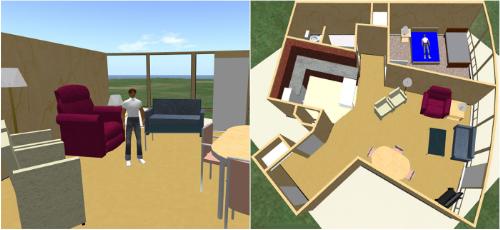 A Canadian university is building a "smart condo" outfitted with sensors and sophisticated monitoring software to research how wireless devices can promote independent living for the elderly.
A Canadian university is building a "smart condo" outfitted with sensors and sophisticated monitoring software to research how wireless devices can promote independent living for the elderly.
Following a successful test at a rehab facility, the Edmonton-based University of Alberta is building a permanent smart condo at the school's new Edmonton Clinic Health Academy. The system relies on three types of sensors and IBM WebSphere Sensor Events software to produce a virtual re-creation of activities within the apartment, visualizing each patient as an avatar. This eliminates the need for intrusive video monitoring.
"The avatar is simulating the activities about the person," Eleni Stroulia, the University of Alberta's research chair for service systems management, tells MobiHealthNews.
The smart condo, which already underwent a three-month test at Glenrose Rehabilitation Hospital in Edmonton through the end of October, contains three different types of sensors. There are sensors embedded in the fixtures and furniture, to measure such things as when someone sat on the couch, got out of bed or opened kitchen cabinets. Other devices monitor environmental conditions such as lighting and temperature, while the third group measures patient health, including blood pressure, heart rate, weight and even whether individuals took their medications as prescribed.
For medication adherence, each patient is assigned an electronic pill dispenser that produces reminders when it's time to take meds. The user pushes a button to open slots with the preloaded proper dosage, and the system records this event.
"All this information goes to our server, gets analyzed, and we make some inferences about the person," Stroulia says. "We want to prove that these [systems] work and that the data is of sufficient quality to show what happens in the apartment," she adds.
The simulations get recorded, and the university plans on showing the recordings to students in health sciences programs as well as to healthcare practitioners.
“We know data is being generated all the time, but harnessing, aggregating, analyzing and gaining insights from it have been challenges. When you view data as diverse as heart rate monitor and electrical consumption independently, out of context, it means very little," Stroulia says in an IBM press release. "The IBM software has enabled us to put it together in a visualization and actually see a patient’s ability to function independently, so clinicians can intervene when necessary and students can learn how best to care for them. It has provided visibility to the physical world in a way we've never been able to see it before."
U of Alberta researchers presented some initial findings from the Glenrose trial Tuesday at an IBM technology conference in Markham, Ontario. They also are looking to publish a study in a peer-reviewed journal to add to the body of scientific evidence about remote monitoring and wireless sensors.
Ongoing research at the permanent smart condo will add monitoring patient use of wheelchairs or walkers and their food intake, two important activities identified during initial pilot.
Stroulia tells MobiHealthNews that the data will help further multidisciplinary care coordination for a growing elderly population that wants to maintain independence and stay out of nursing homes. "The problems are too big for any one discipline," she says.
Citing government statistics, IBM says 24.5 percent of Canadians will be at least 65 years old by 2036—nearly twice the current rate of 13.2 percent and a far greater share of the population than in the US.




















